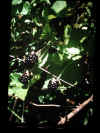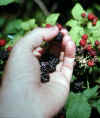| June 2007
June Is Bustiní Out All Over
One of the great features of June is the
mere fact that it has so many features. Thereís something for everyone
in June, to be doubted by nobody. It would be next to impossible to chronicle
all aspects of the month. Suffice it to say, June is a slam-bang month.
That translates into cobblers, pies, jelly, jam,
wine, and who knows what else--would you believe strawberry shortcake,
wild style? And it all starts with wild strawberries, about Memorial Day,
but certainly when June takes its bow. Depending on where one lives, a
phalanx of wild berries and fruits march across the proscenium of summer
and into fall. It would be difficult to find a better scenario for cooks,
bakers, little old winemakers and those who adhere to other berry delights.
And, it has been bandied about, that they are packed with all kinds of
good things for the human body.
As the late Hoosier poet James Whitcomb Riley
put it in Out To Old Aunt Maryís, no other pen could ever
fashion such a beautiful tribute:
The jelly--the jam and the marmalade,
And the cherry and quince preserves she
made!
And the sweet-sour pickles of peach and
pear,
With cinnamon in Ďem, and all things rare!
And the more we ate was the more to spare,
Out To Old Aunt Maryís...
Of course, the timetable will be delayed somewhat
for all wild berries and fruits because the growing rays of the sun are
slower to bathe the north. But keep an eye on the natural order of Mother
Natureís children, and it will be a huge plus in the years to come. Take
notes, if you like.
It may be argued that the produce of nature gets
its start much earlier in the spring--say March or April--with such natural
food as mushrooms, asparagus, poke weed shoots, and many other greens of
the weed class. That may be true. But the real producers of edible items
such as berries, fruits and nuts come on the hardy shrub-types that are
dormant (or nearly so) in the dead of winter. And it all is launched by
the coming of the sun in June. Sure the spring equinox comes late in March,
but May is history when the sun warms to its task. We saw a perfect example
of that natural weather phenomenon in the weeks just past, and we could
have instant replays of it.
In the Midwest wild strawberries parade of berries
(they are annuals) and they are followed by the more hardy plants that
survive the winter. We can, for example, pick wild strawberries (the minute
scarlet gems) a week before Memorial Day. They may be with us until the
first week of June. Wild black raspberries fall into line to ripen after
the third week of June. Falling into line as summer progresses are dewberries,
blackberries,
choke cherries, red raspberries, and (as a last hurrah of the summer berry
season) elderberry. After that comes the late-summer and early-fall season
for persimmons and a wealth of other fruits that have gone wild.
Then come the nuts.
Actually the term berry pickiní is a bit of a
misnomer. Lots of berries arenít really picked. They are sort-of twirled
off the cane. You just sort-of learn to place the palm of the dominant
hand under the cluster of berries (or single), and let the thumb
and index finger twirl it (or them) off and allow it (them) to fall
into the palm to be placed gently into your pail. The pail, of course,
is a two-pound coffee can with a heavy wire bail attached that will hook
over your belt. This arrangement allows one to hold a prickly cane with
one hand, and pick (twirl) with the other. When the coffee-can pail is
full, the berries are transferred to a larger pail.
When berries are ripe and firm it is a good idea
to rinse them in cool tap water; but one must guard against washing away
natural juices of those that are dead ripe and juicy. Berries may also
be frozen for later use.
Another good modus for berry pickiní when this
activity becomes incidental to some other activity--say fishing--is to
start your dayís activities with the not-so-popular, but very useful Bayou
Billís Pail that folds to fit many pockets, but expands to become a very
good container. The decorations for turning a half-gallon milk or citrus
juice container into the Bayou
Bill Pail (I invented it) is explained elsewhere on this web site.
The search engine at the bottom
of opening page will help you find the pail directions.
How important was berry pickiní to the family
in years past? I lived with my parents, grandmother, an older sister, an
older brother, and a younger brother. When blackberries became ripe in
the vast thickets along the New Cut Road, family berry excursions were
a family activity that filled 15, 20--or even 30 gallons of containers,
maybe even a clean washtub.
In those days the children were not asked if they
would like to pick berries on Saturday. They were told it would happen.
And it did.
The rewards, of course, came in the form of blackberry
pies, cobblers, jellies
and jams--well over 100 jars (many quarts) when the first snow blanketed
our little town. But still one of the all-time favorite desserts for poor
folks in those days was a berry biscuit--buttered with creamory butter
and sweetened berries poured over a leftover biscuit, especially when there
had not been time to bake.
I once heard my mother (not boastfully, but certainly
happy about it) tell another lady she had canned more than 100 quarts of
berries that summer (mid-1930s, as I recall), not counting jelly and jam.
The Ball jars were stored as empties on grotesque
frames similar to the cross-arm of utility poles with staves to hold individual
jars to identify ladies of houses as canners. Each jar stored in this manner
was scalded and washed before reuse, of course.
Somebody always dragged an old automobile tire
tube through the dust of the New Cut Road, and circulated the story of
a gigantic snake living in the thickets in an obvious, but unsuccessful
attempt to scare others, but those who braved the conditions never saw
the monster.
Picking berries along the edges of thicket always
offered burgeoning buckets and porcelain water pails, but my dad always
said: You can fill your bucket following the paths of others. But you
get the biggest and sweetest berries making your own paths.
I would learn on my own hook, that shade-ripened
berries are the next things to sugar.
Olí
Blackberry Time
By
Bill Scifres
Talk about your
favorite season, aní Iíll up and tell you mine,
Without fancy
words or phrases, Itís just . . .
Ol' Blackberry
Time!
With pail in hand,
I trudge the dusty lane,
Until the shady
thicket is at hand,
Then part the
brush and slip through walls of briars
Into a world
of wonder--Natureís Land.
Skeeters whine
around my ear, but I dasnít ever hear,
Part the briars
and slip on through, Ďtil big berries bless my view . . .
Pick a few, and
then, by gum,
Sit me down,
and eat me some!
Nen I see the
best of life . . . natureís follies, and her strife . . .
Just like humans,
I declare, wouldnít know Iím hiding there,
Watching lifeís
most simple times . . . seeiní that its just like mine.
Little, ol brown
creeper, he, sneaks on up yon dead elm tree,
Eatiní things
that you and me, never will have eyes to see.
Olí blue jay,
ornery cus, kickiní up an awful fuss
Just because
I found his lair in that walnut fork up there.
Fill my pail then,
slip on back . . . To the road where humans live,
Dust squirts
up between my toes, and I wonder, as I go
Back to town,
do others know, 'bout Blackberry Time. |
Click
on thumbnail image for enlarged view.
| The toe cut off an old
stocking protects forearm from briars. |
 |
| Six dewberries--six sweet,
juicy inches on any ruler. |
 |
| Dewberries
often ripen in shade of rambling, low vine. |
 |
| Blackberries
start green on the old canes, turn red, then black, stain red. |
 |
| With
black raspberries, this photo illustrates the twirling method of pickiní. |
 |
|

